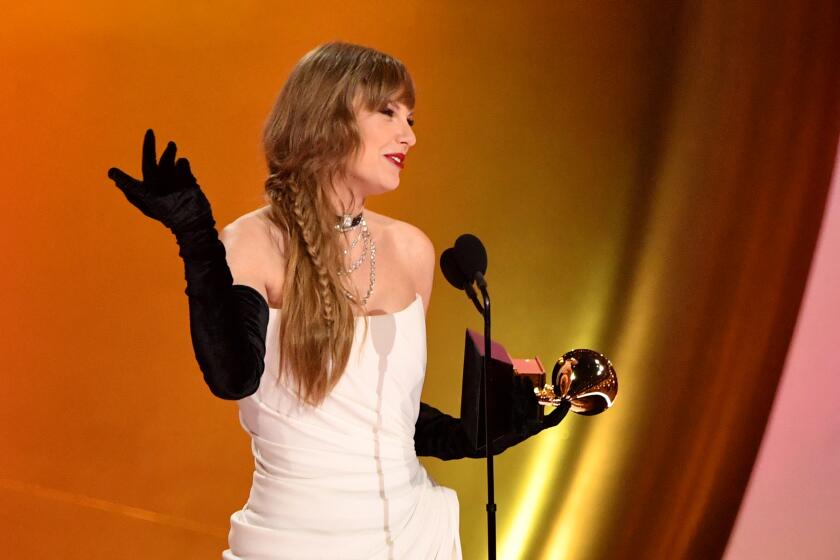How virtual art appearing along the L.A. River tackles gentrification, immigration and environmental issues
Recently, a gleaming white monorail car blazed over the Los Angeles River at the Spring Street bridge. Materializing via augmented and virtual reality technology, the artwork is invisible to the naked eye — accessible only on the artist-made app 4th wall, which is free to download on a smartphone.
For the record:
11:00 a.m. Nov. 3, 2018A previous version of this story misstated the age of Beatriz Cortez as 28, she is 47.
The digital drawing kicks off “Defining Line,” a series of more than eight immersive artworks opening to the public on Nov. 4. Placed at distinct points along the L.A. River, the works deal with urban redevelopment, environmental issues, untold Native histories and patterns of gentrification.
Conceived by artist Nancy Baker Cahill as a public art project, the artworks resist easy categorization as site-specific installations that make use of augmented and virtual reality technology. While researching transit systems that were proposed but never implemented, the co-curator and artist Debra Scacco, 42, uncovered an archival drawing from 1954 of a monorail system that would bisect the city. She resurrected the sketch as a digital drawing, visible in daylight and at night.
“There’s a reason why highways are placed where they are, why trains run above or below ground in certain places,” Scacco explains. “I want more than anyone for L.A. to be more connected, but we have to address that there’s human impact to these infrastructure projects.”
If she were to create a physical iteration of the piece, Scacco would need to raise significant funding, hire a large team, and navigate a series of bureaucratic challenges. (In comparison, a 2016 public art project of sculptural works and projects in and nearby the L.A. River was made possible by a million-dollar award from Bloomberg’s philanthropic arm.) But the VR project was more approachable.
“We’re really activating sites along the river that people wouldn’t think of as sites of cultural significance,” Cahill says, “and asking them to think about histories that have been untold.” Unlike physical artworks, installing virtual artworks leaves no carbon footprint.
The artist Beatriz Cortez, 47, installed twin sculptures at the Hammer Museum and in Glassell Park. Tzolk’in, a steel pyramid that reimagines an ancient Mayan agricultural calendar, will be removed from its site at Bowtie project on the L.A. river in the coming weeks, but its virtual counterpart will live on in the app. According to Cortez, working in virtual reality allowed her to consider warped chronologies and simultaneity. In another iteration, Cortez placed Tzolk’in in Parque Viveros, Mexico, marking the site where, in May 2018, Claudia Gómez González was killed by a U.S. Border Patrol Agent while attempting to cross the Rio Grande river.
“There are so few large works by women artists in public space,” Cortez says, so this project also empowered a wider range of local artists to collaborate.
“To me, the L.A. river is an important symbol of the way the industrialization of Los Angeles has destroyed the environment and many of our homes,” Cortez, who lives in Highland Park, says. She created the work with pedestrians, both people and animals, in mind. “We all have concrete backyards instead of green areas.” In addition to Scacco and Cortez’s projects there are works by social historians and artists, including Carolina Caycedo, Andrea Chung, Nova Jiang, Star Montana, Gala Porras-Kim, and Tongva elder Julia Bogany and her great granddaughter Marissa Bogany.
“It’s a subversive project,” Cahill explains. “It doesn’t rely on permissions from institutions or on the institutions themselves. It exists outside of that.” Her vision to work outside conventional art spaces resonated with this particular group of artists. “I want the work that I make to move very far beyond gallery walls,” Scacco says.
“Defining Line” is an extension of “Coordinates,” a worldwide project that includes site-specific virtual works at the Statue of Liberty in New York, the Great Pyramid of Giza in Egypt, and along the U.S./Mexico border in Tijuana. As Cahill explains, “a piece that might mean one thing in a white cube, will mean something entirely different over the Rio Grande or Liberty Island.”
On Sept. 28, the day after Christine Blasey Ford testified before the Senate Judiciary Committee, Cahill placed a provocative drawing of a twisted female torso on the steps of the U.S. Supreme Court with the all-caps text, UNPROTECTED. “I really interpret the body as a site of struggle and resistance,” Cahill says. “So I’ve been seeking an immersive experience for the viewer. I want to provoke an empathic, embodied reaction.”
“Our democracy is unprotected and under siege,” she continues. “And I think our bodies are under siege.”
She has installed virtual works in Las Vegas, at the site of the October 2017 shootings, and scattered throughout Los Angeles. In installing artworks on government sites, but virtually, she circumvents legal ramifications.
“I’m not interested in bureaucracy,” she explains. “I’m interested in action. And there’s an urgency to this moment. We have a crisis going on.”
While virtual art has sometimes elicited eye rolling reactions from art critics and curators, projects like Cahill’s 4th Wall show that the medium can apply the language of fine art to new media with subversive ends. The artist highlights that if VR/AR technology continues to enable “hyper-violent, militaristic, or pornographic [images], we allow it to be dominated by themes that don’t contribute thoughtfully to culture,” Cahill explains.
“As artists, if we don’t offer dynamic, thought-provoking alternatives, we cede that territory to commercial entities, likely unconcerned with the cultural consequences of their actions.”
Opens Nov. 4, 4thwallapp.org. For iPhone 6s or higher, Android devices with ARCore, and iPads.
More to Read
The biggest entertainment stories
Get our big stories about Hollywood, film, television, music, arts, culture and more right in your inbox as soon as they publish.
You may occasionally receive promotional content from the Los Angeles Times.






